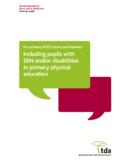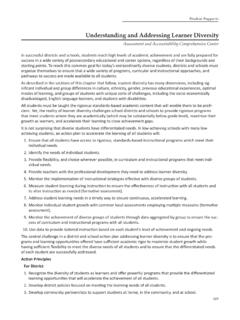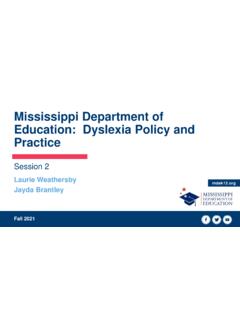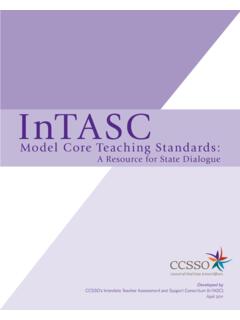Transcription of A Study of Co-Teaching Identifying Effective ...
1 INTERNATIONAL JOURNAL OF SPECIAL EDUCATION , , 2017 A Study of Co-Teaching Identifying Effective Implementation Strategies Joanna Brendle, Robert Lock, Texas Tech University, PO Box 41071, Lubbock, TX 79409 Kate Piazza, Texas Tech University, 26722 Crossroads Trail, Huffman, TX, 77336 Abstract Co-Teaching models have been established in research as an instructional delivery method to provide instruction to diverse students in an inclusive general education setting. Research of inclusive classrooms where general education and special education teachers co-instruct indicates learning for students with learning disabilities (LD) is improved (Cramer, Liston, Nevin & Thousand, 2010).
2 Co-Teaching models have been addressed in the literature, however, responsibilities of general and special education teachers regarding co-planning, co-instruction and co-assessing to implement Co-Teaching effectively requires further investigation (Mastropieri et al., 2005). This qualitative Study investigated two co-taught elementary classrooms. The case Study examined information from teachers in reading and math co-taught classrooms to document method of implementation and to gain insight into participants knowledge and perceptions of Co-Teaching . Information was gathered from two elementary general education and two elementary special education teachers concerning Co-Teaching roles, collaborative, instruction, and assessment .
3 Data were gathered utilizing interviews, 538 INTERNATIONAL JOURNAL OF SPECIAL EDUCATION , , 2017rating scales, and classroom observations. The experience of elementary co-teachers in co-taught classrooms provided descriptive data allowing examination and analysis of co-teachers knowledge, perceptions and implementation of Co-Teaching . Results indicate teachers lack expertise in implementing collaborative co-planning, co-instructing and co-assessing to effectively implement Co-Teaching . The Study identified recommendations for administrative support and teacher training. Keywords: Co-Teaching , students with learning disabilities Introduction The Individuals with disabilities Education Act (IDEA) (2004) mandated that students with disabilities be given access to, be involved in, and make progress in the general education curriculum.
4 In addition, the National Center for Learning disabilities (NCLD) supported the charge of ensuring students with disabilities access to the general education curriculum through advocating for research-based strategies and accountability (Cramer, Liston, Nevin, & Thousand, 2010). Co-Teaching was not required as a method of instruction by this legislation, however, growing accountability for teachers to increase the performance of students in the classroom, to produce students prepared for postsecondary placement, and to provide instruction to diverse students elevated Co-Teaching as a strategy to assist in meeting these goals.
5 Requiring teachers to cover the core curriculum and to guarantee students are acquiring the content has led to implementing strategies such as Co-Teaching in general education classrooms (Vaughn & Bos, 2015). Research in secondary schools supports co-instruction as an Effective method for teachers to provide a diversified classroom with engaging and differentiated instruction (Murawski & Lochner, 2010), however, there are a limited number of Co-Teaching research studies that focused on elementary schools (Tremblay, 2013). This article describes a Study of an elementary school s implementation of Co-Teaching based on teacher rating scales, interviews and classroom observations.
6 In 2015, the Department of Education reported 63 percent of students receiving special education services spent 80 percent of the school day in general education classes, versus 58 percent in 2009 (Wu, 2012; Digest of Education Statistics, 2015). According to the Annual Disability Statistics Compendium report (2015), of special education students in Texas ages 6 to 21 were served more than 40 percent of the instructional day in a general education setting. As students with disabilities placement in the general education classrooms increase, Effective instructional practices require teachers to support all student needs for positive achievement results (McLeskey, Landers, Hoppey & Williamson, 2011).
7 Placing students with disabilities in general education classrooms where teachers are expected to cover the core curriculum and ensure all students are acquiring the content has resulted in schools turning to the current research to implement supportive instructional strategies such as Co-Teaching in general education classrooms (Vaughn & Bos, 2015). Co-Teaching research has identified successful methods of implementing Co-Teaching within their classrooms (Friend, Cook, Hurley-Chamberlain, & Shamberger, 2010; Kim, Woodruff, Klein, & Vaughn, 2006; Kohler-Evans, 2006; Mastropieri, Scruggs, Graetz, Norland, Gardizi, & McDuffie, 2005; Murawski & Lochner, 2010; Ploessl, Rock, Schoenfield, & Blanks, 2010; Rea & Connell, 2005; Thousand, Villa, & Nevin, 2006).
8 Consequently, Co-Teaching has been met with considerable support from schools as a successful instructional method incorporating partnerships among general and special educators to meet the needs of special education students (Murawski & Lochner, 2010). 539 INTERNATIONAL JOURNAL OF SPECIAL EDUCATION , , 2017 The high level of expectation for students with disabilities to be served in the least restrictive environment in a general education setting has resulted in public schools implementing Co-Teaching strategies based on the research indicating positive results of the co-teach model as a key component to enhance success for all students in general education classrooms (Cramer et al.)
9 , 2010; Murawski & Lochner, 2010). Co-Teaching embraces student individuality allowing students with different learning styles and needs to receive instruction in a general education classroom. All students benefit from additional instructional support from two teachers in addition to increased involvement and enrichment of students with disabilities in the general education classroom (Mastropieri et al., 2005). Co-Teaching Co-Teaching models have been widely discussed in the literature, however, exact responsibilities of general and special education teachers in a Co-Teaching setting and the appropriate way to measure Effective Co-Teaching require further investigation (Mastropieri et al.
10 , 2005). Friend (2008) defines Co-Teaching as a general education teacher and special education teacher providing instruction to general and special education students in a general education classroom. Research supports findings that instruction has improved with general education and special education teachers educating students in one classroom and supplementing with aids and services to students with disabilities (Cramer et al., 2010). Research describes the following Co-Teaching methods, noting that one approach is not more appropriate than the other, instead teachers should determine the instructional model dependent upon the content to be taught (Friend, 2008; Thousand et al.

















